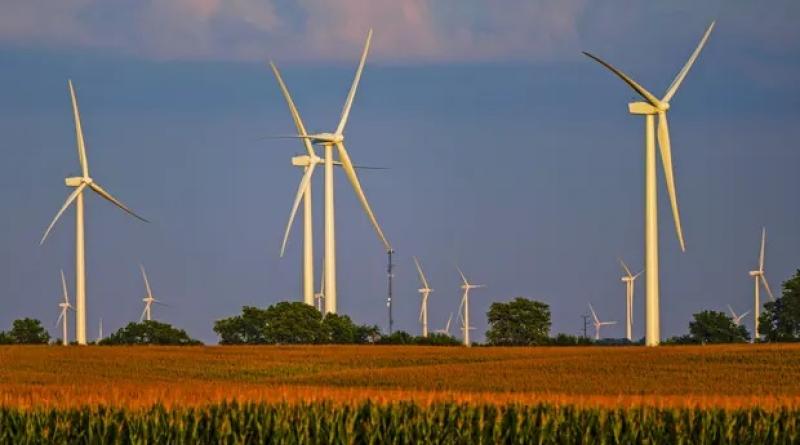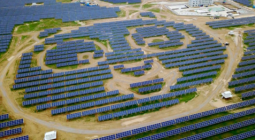US renewable energy farms outstrip 99% of coal plants economically – study

It is cheaper to build solar panels or cluster of wind turbines and connect them to the grid than to keep operating coal plants
Coal in the US is now being economically outmatched by renewables to such an extent that it’s more expensive for 99% of the country’s coal-fired power plants to keep running than it is to build an entirely new solar or wind energy operation nearby, a new analysis has found.
The plummeting cost of renewable energy, which has been supercharged by last year’s Inflation Reduction Act, means that it is cheaper to build an array of solar panels or a cluster of new wind turbines and connect them to the grid than it is to keep operating all of the 210 coal plants in the contiguous US, bar one, according to the study.
“Coal is unequivocally more expensive than wind and solar resources, it’s just no longer cost competitive with renewables,” said Michelle Solomon, a policy analyst at Energy Innovation, which undertook the analysis. “This report certainly challenges the narrative that coal is here to stay.”
The new analysis, conducted in the wake of the $370bn in tax credits and other support for clean energy passed by Democrats in last summer’s Inflation Reduction Act, compared the fuel, running and maintenance cost of America’s coal fleet with the building of new solar or wind from scratch in the same utility region.
On average, the marginal cost for the coal plants is $36 each megawatt hour, while new solar is about $24 each megawatt hour, or about a third cheaper. Only one coal plant – Dry Fork in Wyoming – is cost competitive with the new renewables. “It was a bit surprising to find this,” said Solomon. “It shows that not only have renewables dropped in cost, the Inflation Reduction Act is accelerating this trend.”
Coal, which is a heavily carbon-intensive fuel and responsible for 60% of planet-heating emissions from electricity generation, once formed the backbone of the American grid, generating enough power to light up 186m homes at its peak in 2007. However, by 2021 this output had dropped by 55%, while jobs in the coal mining sector have more than halved over the past decade, to less than 40,000.
Most of the US’s coal plants are aging and increasingly expensive to maintain, while their fuel source has been widely displaced by cheap sources of gas. Environmental regulations, which Donald Trump vowed to roll back in an unfulfilled mission to revive the coal industry when president, have also imposed costs on the sector by enforcing cuts to toxic emissions such as mercury and sulphur dioxide.
Coal production hit a 55-year low in 2020 but the industry saw subsequent signs of an uptick in the wake of Russia’s invasion of Ukraine, which pushed up the price of energy worldwide and saw pressure on countries to find an alternative fuel source to Russian gas.
Supporters of coal contend it is a reliable fuel source at a time of instability and have attacked Joe Biden for attempting to shift the US away from fossil fuels. “Forcing essential coal capacity off the grid – without reliable alternatives and the infrastructure to support them – will only deepen reliability and economic challenges,” said Rich Nolan, president of the National Mining Association, in November.
“Look to our friends in Europe, who blindly rushed to close coal plants at a rapid pace and are now working from Germany to Denmark to bring those same plants back online. The global energy crisis is real and imposing costly burdens on people around the world and here at home; taking deliberate steps to intensify that crisis is reckless and unthinkable.”
While coal is in long-term decline it is unlikely to disappear in the immediate future – many utilities are still deeply invested in the fuel source and the scale of renewable infrastructure, including energy projects, new transmission lines and battery and other storage to cope with intermittent delivery, isn’t yet vast enough to trigger a mass shutdown of coal. But analysts say the broader trends, bolstered by last year’s climate spending, look set to call time on the era of coal.
“We can’t just snap our fingers and retire all coal plants but we need to accelerate the buildout of wind and solar so that when the time comes we can wean ourselves off coal,” said Solomon.
“There’s a huge opportunity here to invest in coal communities, build local economic resilience and save money in the process.”
James Stock, an economist at Harvard University who was not involved in the Energy Innovation report, said the analysis “rings true” and that coal is no longer economically competitive.
“We can’t shutter all these plants tomorrow, we need to do it in an orderly fashion to support grid reliability but we should be able to do it in fairly fast order,” he said. “Coal has been on a natural decline due to economics and those economics are going to continue, this is a transition that’s just going to happen.
“We built a lot of coal plants in the US around 50 years ago because we were worried about energy security in the world. That made sense at the time and they made an important contribution. But we know a lot more now about climate change, so now we need to make different decisions.”
COVER PHOTO: The plummeting cost of energy has been supercharged by last year’s Inflation Reduction Act. Photograph: Tannen Maury/EPA



